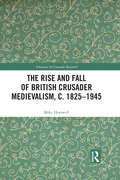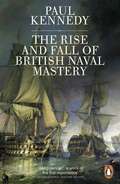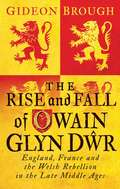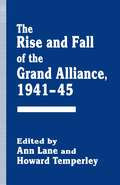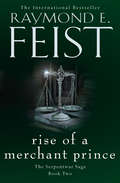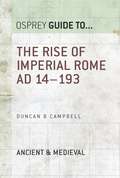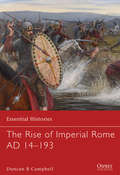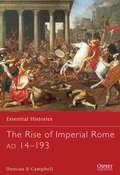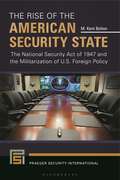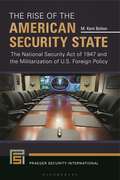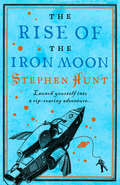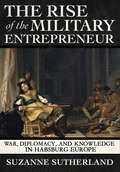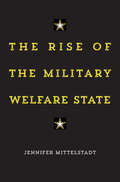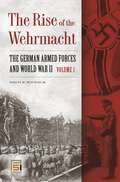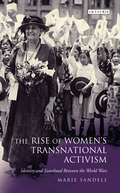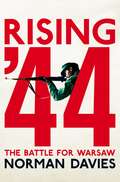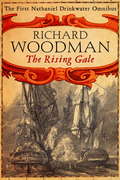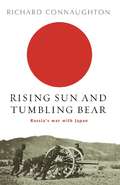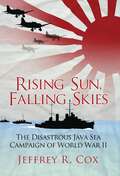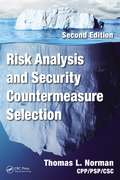- Table View
- List View
The Rise and Fall of British Crusader Medievalism, c.1825–1945 (Advances in Crusades Research)
by Mike HorswellThis book investigates the uses of crusader medievalism – the memory of the crusades and crusading rhetoric and imagery – in Britain, from Walter Scott’s The Talisman (1825) to the end of the Second World War. It seeks to understand why and when the crusades and crusading were popular, how they fitted with other cultural trends of the Victorian and Edwardian eras, how their use was affected by the turmoil of the First World War and whether they were differently employed in the interwar years and in the 1939-45 conflict. Building on existing studies and contributing the fruits of fresh research, it brings together examples of the uses of the crusades from disparate contexts and integrates them into the story of the rise and fall crusader medievalism in Britain.
The Rise And Fall of British Naval Mastery
by Paul KennedyPaul Kennedy's classic naval history, now updated with a new introduction by the authorThis acclaimed book traces Britain's rise and fall as a sea power from the Tudors to the present day. Challenging the traditional view that the British are natural 'sons of the waves', he suggests instead that the country's fortunes as a significant maritime force have always been bound up with its economic growth. In doing so, he contributes significantly to the centuries-long debate between 'continental' and 'maritime' schools of strategy over Britain's policy in times of war. Setting British naval history within a framework of national, international, economic, political and strategic considerations, he offers a fresh approach to one of the central questions in British history. A new introduction extends his analysis into the twenty-first century and reflects on current American and Chinese ambitions for naval mastery.'Excellent and stimulating' Correlli Barnett'The first scholar to have set the sweep of British Naval history against the background of economic history' Michael Howard, Sunday Times'By far the best study that has ever been done on the subject ... a sparkling and apt quotation on practically every page' Daniel A. Baugh, International History Review'The best single-volume study of Britain and her naval past now available to us' Jon Sumida, Journal of Modern History
The Rise and Fall of Owain Glyn Dwr: England, France and the Welsh Rebellion in the Late Middle Ages
by Gideon BroughOwain Glyndwr is a towering figure in Welsh history. He was the warrior who led the Welsh Revolt and the last war of Welsh independence (1400-1415). He defeated Henry IV's army, was a worthy opponent of the king's champion, the legendary Henry Percy - 'Hotspur' – and last native Welshman to bear the title Prince of Wales. He held court at Harlech and envisioned an independent Welsh state and church with national universities. Yet Glyndwr's success was short-lived - his ultimate defeat at the hands of the English saw the final abandonment of the Welsh cause by France and his own disappearance into an unmarked grave. Gideon Brough here provides a new biography of this iconic man – as military leader, diplomat, medieval statesman and staunch Welsh nationalist.
The Rise and Fall of Peace on Earth
by Michael MandelbaumIn the twenty-five years after 1989, the world enjoyed the deepest peace in history. In The Rise and Fall of Peace on Earth, the eminent foreign policy scholar Michael Mandelbaum examines that remarkable quarter century, describing how and why the peace was established and then fell apart. To be sure, wars took place in this era, but less frequently and on a far smaller scale than in previous periods. Mandelbaum argues that the widespread peace ended because three major countries -- Vladimir Putin's Russia in Europe, Xi Jinping's China in East Asia, and the Shia clerics' Iran in the Middle East -- put an end to it with aggressive nationalist policies aimed at overturning the prevailing political arrangements in their respective regions. The three had a common motive: their need to survive in a democratic age with their countries' prospects for economic growth uncertain. Mandelbaum further argues that the key to the return of peace lies in the advent of genuine democracy, including free elections and the protection of religious, economic, and political liberty. Yet, since recent history has shown that democracy cannot be imposed from the outside, The Rise and Fall of Peace on Earth has a dual message: while the world has a formula for peace, there is no way to ensure that all countries will embrace it.
The Rise and Fall of Peace on Earth
by Michael MandelbaumIn the twenty-five years after 1989, the world enjoyed the deepest peace in history. In The Rise and Fall of Peace on Earth, the eminent foreign policy scholar Michael Mandelbaum examines that remarkable quarter century, describing how and why the peace was established and then fell apart. To be sure, wars took place in this era, but less frequently and on a far smaller scale than in previous periods. Mandelbaum argues that the widespread peace ended because three major countries -- Vladimir Putin's Russia in Europe, Xi Jinping's China in East Asia, and the Shia clerics' Iran in the Middle East -- put an end to it with aggressive nationalist policies aimed at overturning the prevailing political arrangements in their respective regions. The three had a common motive: their need to survive in a democratic age with their countries' prospects for economic growth uncertain. Mandelbaum further argues that the key to the return of peace lies in the advent of genuine democracy, including free elections and the protection of religious, economic, and political liberty. Yet, since recent history has shown that democracy cannot be imposed from the outside, The Rise and Fall of Peace on Earth has a dual message: while the world has a formula for peace, there is no way to ensure that all countries will embrace it.
The Rise and Fall of the Grand Alliance, 1941–45
by Ann Lane Howard TemperleyThis collection by leading British and American scholars on twentieth century international history covers the strategy, diplomacy and intelligence of the Anglo-American-Soviet alliance during the Second World War. It includes the evolution of allied war aims in both the European and Pacific theatres, the policies surrounding the development and use of the atomic bomb and the evolution of the international intelligence community. It also considers the origins and consequences of inter-allied economic relations as they emerged during the war and the personal relationship between Winston Churchill and Franklin D. Roosevelt.
The Rise and Fall of the Queen of Suburbia: A Black-hearted Soap Opera
by Sarah MayDo you know what your neighbours get up to behind closed doors? And more to the point, do you want to know? ‘The Rise and Fall of the Queen of Suburbia is a darkly comic portrayal of marriage, relationships, neighbours and suburbia.
Rise of a Merchant Prince: Book Two Of The Serpentwar Saga (The Serpentwar Saga #2)
by Raymond E. FeistThe second book in the bestselling Serpentwar series.
The Rise of Imperial Rome AD 14–193 (Guide to...)
by Duncan B CampbellIn this book Duncan Campbell explores the course of the wars that ensued as successive emperors sought to extend the empire, from Claudius' conquest of Britannia, Domitian's campaigns on the Rhine and the Danube, through Trajan's Dacian Wars and Parthian War, to Marcus Aurelius' Marcomannic Wars, as well as the Jewish Wars. The period covered in this book ends with the consolidation of the Roman frontiers along the Rhine and Danube. This book provides a summary of the strengths, limitations and evolving character of the Roman army during the first two centuries AD, as well as those of the forces of Rome's enemies across the Rhine and Danube in Germany and Romania, and in the East, in the form of the Parthian empire of Iraq/Iran. Fully illustrated with photographs depicting the emperors, their armies and enemies, and the remains of Roman fortifications and public buildings, plus informative full-colour maps, this is the epic story of the wars waged by a succession of emperors during the period in which Imperial Rome reached its zenith.
The Rise of Imperial Rome AD 14–193 (Essential Histories)
by Duncan B CampbellIn this book Duncan Campbell explores the course of the wars that ensued as successive emperors sought to extend the empire, from Claudius' conquest of Britannia, Domitian's campaigns on the Rhine and the Danube, through Trajan's Dacian Wars and Parthian War, to Marcus Aurelius' Marcomannic Wars, as well as the Jewish Wars. The period covered in this book ends with the consolidation of the Roman frontiers along the Rhine and Danube. This book provides a summary of the strengths, limitations and evolving character of the Roman army during the first two centuries AD, as well as those of the forces of Rome's enemies across the Rhine and Danube in Germany and Romania, and in the East, in the form of the Parthian empire of Iraq/Iran. Fully illustrated with photographs depicting the emperors, their armies and enemies, and the remains of Roman fortifications and public buildings, plus informative full-colour maps, this is the epic story of the wars waged by a succession of emperors during the period in which Imperial Rome reached its zenith.
The Rise of Imperial Rome AD 14–193 (Essential Histories)
by Duncan B CampbellIn this book Duncan Campbell explores the course of the wars that ensued as successive emperors sought to extend the empire, from Claudius' conquest of Britannia, Domitian's campaigns on the Rhine and the Danube, through Trajan's Dacian Wars and Parthian War, to Marcus Aurelius' Marcomannic Wars, as well as the Jewish Wars. The period covered in this book ends with the consolidation of the Roman frontiers along the Rhine and Danube. This book provides a summary of the strengths, limitations and evolving character of the Roman army during the first two centuries AD, as well as those of the forces of Rome's enemies across the Rhine and Danube in Germany and Romania, and in the East, in the form of the Parthian empire of Iraq/Iran. Fully illustrated with photographs depicting the emperors, their armies and enemies, and the remains of Roman fortifications and public buildings, plus informative full-colour maps, this is the epic story of the wars waged by a succession of emperors during the period in which Imperial Rome reached its zenith.
The Rise of the American Security State: The National Security Act of 1947 and the Militarization of U.S. Foreign Policy (Praeger Security International)
by M. Kent BoltonThis book examines the impact of the National Security Act of 1947, the most important foreign policy legislation that many Americans (including policymakers and academics) have never heard of.Since September 11, 2001, the White House—under both Bush and Obama—has pushed the envelope of taking the United States to war (without declarations), interrogating prisoners of war, spying on potential threats, and acting unilaterally. Why have these trends occurred? How has the apex of foreign power shifted, causing a sea change that has fueled a continual turf war between Capitol Hill and the White House? And perhaps most critically, what is America's role in the world now, and what should it be? The Rise of the American Security State: The National Security Act of 1947 and the Militarization of U.S. Foreign Policy argues that the National Security Act of 1947 and the early Cold War created a bipartisan consensus among U.S. policymakers that spanned several administrations. The result of this consensus and the National Security Act was the creation of permanent institutions: the permanent Defense Department with a secretary of defense; the intelligence community, which has grown to 17 agencies; and significantly, the National Security Council inside the presidency. Collectively, these three developments have led to the militarization of U.S. foreign policy. Readers will grasp how concepts and strategies that were in their infancy during the Cold War era have persisted and continued to affect today's U.S. foreign policy.
The Rise of the American Security State: The National Security Act of 1947 and the Militarization of U.S. Foreign Policy (Praeger Security International)
by M. Kent BoltonThis book examines the impact of the National Security Act of 1947, the most important foreign policy legislation that many Americans (including policymakers and academics) have never heard of.Since September 11, 2001, the White House—under both Bush and Obama—has pushed the envelope of taking the United States to war (without declarations), interrogating prisoners of war, spying on potential threats, and acting unilaterally. Why have these trends occurred? How has the apex of foreign power shifted, causing a sea change that has fueled a continual turf war between Capitol Hill and the White House? And perhaps most critically, what is America's role in the world now, and what should it be? The Rise of the American Security State: The National Security Act of 1947 and the Militarization of U.S. Foreign Policy argues that the National Security Act of 1947 and the early Cold War created a bipartisan consensus among U.S. policymakers that spanned several administrations. The result of this consensus and the National Security Act was the creation of permanent institutions: the permanent Defense Department with a secretary of defense; the intelligence community, which has grown to 17 agencies; and significantly, the National Security Council inside the presidency. Collectively, these three developments have led to the militarization of U.S. foreign policy. Readers will grasp how concepts and strategies that were in their infancy during the Cold War era have persisted and continued to affect today's U.S. foreign policy.
The Rise of the Iron Moon
by Stephen HuntFrom the author of The Court of the Air and The Kingdom Beyond the Waves comes a thrilling new adventure set in the same Victorian-style world. Perfect for fans of Philip Pullman and Susanna Clarke.
The Rise of the Military Entrepreneur: War, Diplomacy, and Knowledge in Habsburg Europe
by Suzanne SutherlandThe Rise of the Military Entrepreneur explores how a new kind of international military figure emerged from, and exploited, the seventeenth century's momentous political, military, commercial, and scientific changes. In the era of the Thirty Years' War, these figures traveled rapidly and frequently across Europe using private wealth, credit, and connections to raise and command the armies that rulers desperately needed. Their careers reveal the roles international networks, private resources, and expertise played in building and at times undermining the state.Suzanne Sutherland uncovers the influence of military entrepreneurs by examining their activities as not only commanders but also diplomats, natural philosophers, information brokers, clients, and subjects on the battlefield, as well as through strategic marital and family allegiances. Sutherland focuses on Raimondo Montecuccoli (1609–80), a middling nobleman from the Duchy of Modena, who became one of the most powerful men in the Austrian Habsburg monarchy and helped found a new discipline, military science. The Rise of the Military Entrepreneur explains how Montecuccoli successfully met battlefield, court, and family responsibilities while contributing to the world of scholarship on an often violent, fragmented political-military landscape. As a result, Sutherland shifts the perspective on war away from the ruler and his court to instead examine the figures supplying force, along with their methods, networks, and reflections on those experiences.
The Rise of the Military Welfare State
by Jennifer MittelstadtAfter Vietnam the army promised its all-volunteer force a safety net long reserved for career soldiers: medical and dental care, education, child care, financial counseling, housing assistance, legal services. Jennifer Mittelstadt shows how this unprecedented military welfare system expanded at a time when civilian programs were being dismantled.
The Rise of the Wehrmacht [2 volumes]: The German Armed Forces and World War II [2 volumes] (Praeger Security International)
by Samuel W. Jr.The Rise of the Wehrmacht is the first comprehensive work to deal with the German war effort in World War II from this point of view. Its uniqueness lies in the fact that it covers the entire war effort from the point of view of the German military that actually conducted and fought the war, something that has never been done before on this scale. Excellent books have been written about the German Army, Navy, the Luftwaffe, and the SS, as well as about the Panzer branch, the parachute arm, the U-Boat forces, etc., but this is the first to cover them all in depth.Mitcham also covers the German Wehrkreise (roughly translated as military district) system in depth and recognizes its importance, both in the formation and expansion of the German Army before the war and in its continuing importance throughout the conflict. He deals with the German rearmament in greater depth and detail than has been done before, points out the importance of the police in the development of Germany's reserves before and during World War II, and offers new insights into the evolution and development of the German military doctrine of Kesselschlact (the decisive battle of encirclement and annihilation). In addition, The Rise of the Wehrmacht explains the problems the Wehrmacht faced because of its too rapid expansion. This expansion was far more rapid than the German generals intended and resulted in many problems, especially in terms of equipment shortages and a shortage of qualified officers. Finally, Mitcham addresses the contributions of the Hitler Youth to the war effort, where their work on farms, fire and rescue crews, in nursing, and as postal workers, for example, provided essential services to German infrastructure.
The Rise of Women's Transnational Activism: Identity and Sisterhood Between the World Wars (International Library of Twentieth Century History #Vol. 36)
by Marie SandellWhat characterised women's international co-operation in the interwar period? How did female activists from different countries and continents relate to one another? Marie Sandell here explores the changing experiences of women involved in the major international women's organisations - including the International Council of Women, International Alliance of Women, Women's International League for Peace and Freedom, and the International Federation of University Women - as well as the changing compositions and aims of the organisations themselves. Moving beyond an Anglo-American focus, Sandell analyses what the term 'international sisterhood' meant in this broader context, which for the first time included women from the beyond the Western world. Focusing on shifting identities, this book investigates how notions of 'sisterhood' were played out, and contested, during the interwar period and will be invaluable reading for scholars of women's history and twentieth-century world history.
Rising '44: The Battle for Warsaw
by Norman DaviesRising '44 is a brilliant narrative account of one of the most dramatic episodes in 20th century history, drawing on Davies' unique understanding of the issues and characters involved. In August 1944 Warsaw offered the Wehrmacht the last line of defence against the Red Army's march from Moscow to Berlin. When the Red Army reached the river Vistula, the people of Warsaw believed that liberation had come. The Resistance took to the streets in celebration, but the Soviets remained where they were, allowing the Wehrmacht time to regroup and Hitler to order that the city of Warsaw be razed to the ground. For 63 days the Resistance fought on in the cellars and the sewers. Defenceless citizens were slaughtered in their tens of thousands. One by one the City's monuments were reduced to rubble, watched by Soviet troops on the other bank of the river. The Allies expressed regret but decided that there was nothing to be done, Poland would not be allowed to be governed by Poles. The sacrifice was in vain and the Soviet tanks rolled in to the flattened city. It is a hugely dramatic story, vividly and authoritatively told by one of our greatest historians.
The Rising Gale: An Eye of the Fleet, A King's Cutter, A Brig of War (Nathaniel Drinkwater Omnibus)
by Richard WoodmanAN EYE OF THE FLEET Nathaniel Drinkwater is engaged in dramatic action off the coast of Spain in Admiral Rodney's famous Moonlight Battle and the capture of the Santa Teresa. But his adventures also bring rebellion on board and a perilous expedition into the Carolina swamps. A KING'S CUTTER Clandestine operations off the coast of France aboard the twelve-gun cutter Kestrel involves Drinkwater in the French Revolution, rescuing refugees from Madame Guillotine and helping British agents infiltrate France. A BRIG OF WAR At the request of Nelson himself, Drinkwater is despatched to the Red Sea on an urgent mission, and he soon finds himself on a thrilling naval operation on the flank of Napoleon's Egyptian campaign.
Rising Sun And Tumbling Bear: Russia's War with Japan (CASSELL MILITARY PAPERBACKS)
by Richard ConnaughtonThe definitive history of the Russo-Japanese warThe Russians were wrong-footed from the start, fighting in Manchuria at the end of a 5,000 mile single track railway; the Japanese were a week or so from their bases. The Russian command structure was hopelessly confused, their generals old and incompetent, the Tsar cautious and uncertain. The Russian naval defeat at Tsushima was as farcical as it was complete. The Japanese had defeated a big European power, and the lessons for the West were there for all to see, had they cared to do so. From this curious war, so unsafely ignored for the most part by the military minds of the day, Richard Connaughton has woven a fascinating narrative to appeal to readers at all levels.
Rising Sun, Falling Skies: The disastrous Java Sea Campaign of World War II
by Jeffrey CoxFollowing the attack on Pearl Harbor, the Japanese offensive in the Far East seemed unstoppable. Allied forces engaged in a futile attempt to halt their rapid advance, culminating in the massed fleet of American, British, Dutch, and Australian forces (ABDA) clashing with the Japanese at the battle of the Java Sea – the first major sea battle of World War II in the Pacific. But, in a campaign crippled by poor leadership and disastrous decisions, the Allied response was catastrophic, losing their largest warships and their tenuous toe-hold in the south Pacific within the first 72 hours of the battle. This defeat left ground troops cut off from reinforcement and supply, with obsolete equipment, no defense against endless Japanese air attacks, and with no chance of retreat. However, although command decisions were to condemn the Allies to defeat, the Allied goal was never an outright victory, simply a delaying action. Facing a relentless and thoroughly vicious enemy, the combined forces responded not by running or surrendering, but by defiantly holding on in a struggle that was as much a test of character, bravery, and determination as it was a test of arms, ultimately costing the Allies ten vessels and the lives of 2,100 brave sailors. In Rising Sun, Falling Skies, Jeffrey Cox examines the events and evidence surrounding the Java Sea Campaign, reconstructing battles that in hindsight were all but hopeless and revealing where fatal mistakes and missed opportunities condemned the Allied forces in an insightful and compelling study of the largely overlooked clash in the Java Sea.
Rising Sun, Falling Skies: The disastrous Java Sea Campaign of World War II (General Military Ser.)
by Jeffrey CoxFollowing the attack on Pearl Harbor, the Japanese offensive in the Far East seemed unstoppable. Allied forces engaged in a futile attempt to halt their rapid advance, culminating in the massed fleet of American, British, Dutch, and Australian forces (ABDA) clashing with the Japanese at the battle of the Java Sea – the first major sea battle of World War II in the Pacific. But, in a campaign crippled by poor leadership and disastrous decisions, the Allied response was catastrophic, losing their largest warships and their tenuous toe-hold in the south Pacific within the first 72 hours of the battle. This defeat left ground troops cut off from reinforcement and supply, with obsolete equipment, no defense against endless Japanese air attacks, and with no chance of retreat. However, although command decisions were to condemn the Allies to defeat, the Allied goal was never an outright victory, simply a delaying action. Facing a relentless and thoroughly vicious enemy, the combined forces responded not by running or surrendering, but by defiantly holding on in a struggle that was as much a test of character, bravery, and determination as it was a test of arms, ultimately costing the Allies ten vessels and the lives of 2,100 brave sailors. In Rising Sun, Falling Skies, Jeffrey Cox examines the events and evidence surrounding the Java Sea Campaign, reconstructing battles that in hindsight were all but hopeless and revealing where fatal mistakes and missed opportunities condemned the Allied forces in an insightful and compelling study of the largely overlooked clash in the Java Sea.
Risk Analysis and Security Countermeasure Selection
by Thomas L. Norman CPP/PSP/CSCThis new edition of Risk Analysis and Security Countermeasure Selection presents updated case studies and introduces existing and new methodologies and technologies for addressing existing and future threats. It covers risk analysis methodologies approved by the U.S. Department of Homeland Security and shows how to apply them to other organizations
Risk Analysis and Security Countermeasure Selection
by Thomas L. Norman CPP/PSP/CSCThis new edition of Risk Analysis and Security Countermeasure Selection presents updated case studies and introduces existing and new methodologies and technologies for addressing existing and future threats. It covers risk analysis methodologies approved by the U.S. Department of Homeland Security and shows how to apply them to other organizations
